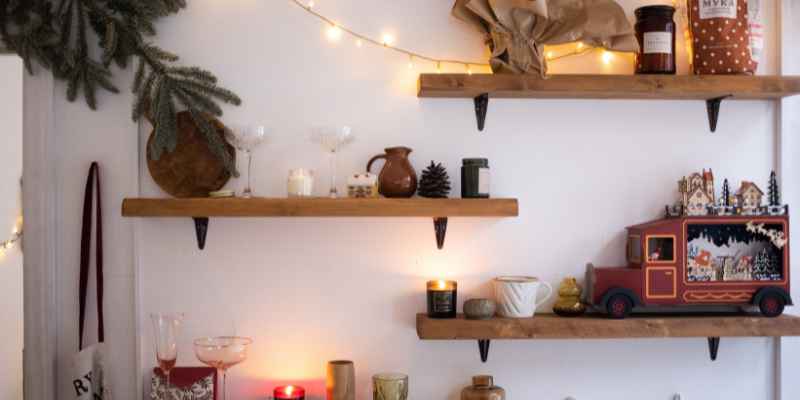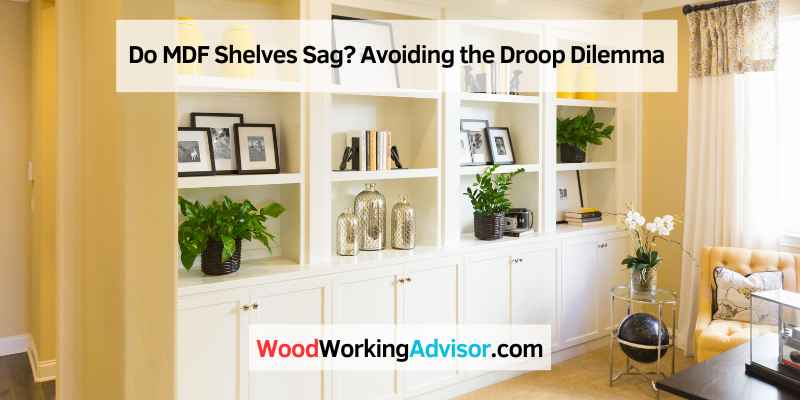Yes, MDF shelves can sag over time due to weight and moisture exposure. This can affect the shelf’s durability and aesthetics.
MDF, or medium-density fiberboard, is a popular material for shelves due to its affordability and smooth finish. However, it is prone to sagging when overloaded or exposed to high humidity levels. Understanding the causes of sagging can help prevent damage and prolong the lifespan of your MDF shelves.
In this blog post, we will explore why MDF shelves sag, how to prevent it, and solutions to fix sagging shelves. Let’s dive in and learn how to keep your shelves sturdy and functional for years to come.
The Nature Of MDF
MDF, or medium-density fibreboard, is a popular choice for shelving due to its affordability and versatility. However, it is essential to understand the nature of MDF to address the common concern of sagging shelves. Let’s explore the composition and use of MDF, as well as its benefits and drawbacks.
Composition And Use
MDF is made by breaking down hardwood or softwood residuals into wood fibers, often in a defibrator, combining it with wax and a resin binder, and forming panels by applying high temperature and pressure. These panels are then used in various applications, including shelving, furniture, cabinetry, and decorative molding.
Benefits And Drawbacks
- Affordability: MDF is a cost-effective option for shelving and furniture.
- Versatility: It can be easily shaped, cut, and painted to achieve different styles.
- Smooth Surface: MDF provides a smooth and uniform surface for painting and finishing.
- Prone to Sagging: MDF shelves may sag under heavy weight if not properly supported.
- Moisture Sensitivity: Exposure to moisture can cause swelling and damage to MDF.
- Toxicity: The formaldehyde-based resins used in MDF production can emit harmful fumes.
Sagging Shelves: A Common Concern
MDF shelves can sag under heavy weight due to their composition. Sagging shelves are a common issue, especially when overloaded. Regular maintenance and using shelf brackets for support can help prevent this problem.
Factors Leading To Sagging
When it comes to choosing shelves for your home, one of the most common concerns is sagging. Sagging shelves not only look unattractive but also pose a risk to your safety. Several factors can cause shelves to sag, including the type of material used, weight distribution, and installation method. It’s essential to understand these factors to prevent sagging and ensure your shelves remain sturdy and reliable.
MDF Vs. Solid Wood And Plywood
MDF (medium-density fiberboard) is a popular choice for shelves due to its affordability and durability. However, MDF shelves are more prone to sagging than solid wood and plywood. The reason behind this is the nature of MDF, which is made by compressing wood fibers and resin together. While this makes MDF strong and sturdy, it also means it lacks the natural grain structure that solid wood and plywood possess. As a result, MDF shelves are more likely to bend or sag under heavy weight or over time.
Preventing Sagging
To prevent sagging shelves, it’s crucial to choose the right material and ensure proper weight distribution. If you prefer MDF, opt for thicker shelves that can withstand more weight. Additionally, avoid overloading your shelves with heavy objects, and distribute weight evenly across the surface. It’s also essential to choose the right installation method and hardware to secure your shelves properly.
In conclusion, sagging shelves are a common concern, but they can be prevented with the right materials, weight distribution, and installation method. While MDF shelves are more prone to sagging than solid wood and plywood, they can still be a reliable option if proper care is taken. By understanding the factors that lead to sagging and taking preventive measures, you can ensure your shelves remain sturdy and safe for years to come.
Analyzing MDF Shelf Durability
MDF shelves are prone to sagging due to their composition of compressed wood fibers. Analyzing their durability involves testing weight capacity and shelf thickness to determine their ability to withstand weight over time.
Weight Capacity
MDF shelves can sag due to exceeding weight limits.
Environmental Impact
Consider the eco-friendliness of MDF material.
Analyzing MDF Shelf Durability:
MDF shelves can experience sagging if overloaded. Factors like weight capacity and environmental impact play crucial roles in determining the durability of MDF shelves.
Weight Capacity
– Exceeding weight limits can lead to sagging.
– Distribute weight evenly to prevent damage.
Environmental Impact
– Evaluate eco-friendliness of MDF material.
– Consider sustainable alternatives for shelving solutions.
Preventive Measures For MDF Shelves

MDF (Medium Density Fiberboard) shelves are a popular choice for their affordability, versatility, and smooth surface. However, one common issue that can arise with MDF shelves is sagging over time. To ensure the longevity and durability of your MDF shelves, it is essential to take preventive measures during installation and consider factors like thickness. In this section, we will explore some key preventive measures that can help you avoid sagging in MDF shelves.
Proper Installation
Proper installation is crucial in preventing sagging in MDF shelves. When installing your shelves, make sure to follow these steps:
- Use sturdy brackets or supports that are suitable for the weight and size of the shelf.
- Ensure that the brackets are securely attached to the wall studs or a solid backing.
- Place the brackets at an appropriate distance to evenly distribute the weight across the shelf.
- Avoid overloading the shelves with excessive weight, as this can lead to sagging over time.
Choosing The Right Thickness
The thickness of the MDF board used for your shelves can significantly impact their resistance to sagging. Here are some guidelines to consider:
| MDF Thickness | Recommended Usage |
|---|---|
| 1/2 inch (12mm) | Ideal for smaller shelves or lighter items. |
| 3/4 inch (18mm) | Provides better support for larger shelves or heavier items. |
Choosing the appropriate thickness based on the intended usage of your shelves can help prevent sagging and ensure their long-term stability.
By following proper installation techniques and selecting the right thickness for your MDF shelves, you can significantly reduce the risk of sagging and enjoy sturdy and reliable storage solutions. Remember, taking preventive measures is key to maintaining the integrity and functionality of your MDF shelves for years to come.
Reinforcement Strategies
MDF shelves can sag over time, but there are effective reinforcement strategies to prevent this issue. By using additional support brackets or installing reinforcing strips underneath the shelves, you can ensure their stability and longevity.
MDF shelves are a popular choice for their affordability and versatility. However, they are prone to sagging under heavy weight or prolonged use. Reinforcement strategies can help prevent sagging and extend the life of your MDF shelves. Here are two effective reinforcement strategies to consider:
Support Brackets
Adding support brackets is a simple and effective way to reinforce MDF shelves. Brackets should be installed underneath the shelves and secured to the wall. Use a stud finder to locate the wall studs and install the brackets accordingly. This will distribute the weight of the shelf evenly and prevent sagging.
Edge Banding
Edge banding is another effective reinforcement strategy that can help prevent MDF shelves from sagging. This involves applying a strip of wood or plastic to the edge of the shelf. The banding should be flush with the surface of the shelf and secured with adhesive or nails. This will strengthen the shelf and prevent the edges from splitting or chipping.
In conclusion, sagging MDF shelves can be a frustrating problem to deal with, but reinforcement strategies like support brackets and edge banding can help prevent it. By taking these simple steps, you can extend the life of your MDF shelves and ensure they remain sturdy and reliable.
The Role Of Humidity And Temperature
Humidity and temperature play a crucial role in determining whether MDF shelves will sag over time.
Effects On MDF
High humidity can cause MDF to absorb moisture and swell, leading to sagging shelves.
Extreme temperatures can also affect the structural integrity of MDF, contributing to sagging issues.
Controlling Environmental Factors
- Maintain humidity levels around 40-60% to prevent moisture absorption.
- Avoid placing MDF shelves near heat sources to prevent warping.
- Use dehumidifiers or air conditioners in humid environments to control moisture levels.
When To Replace Vs. Repair
When considering whether to replace or repair MDF shelves that sag, assess the extent of the damage. If sagging is severe and compromises functionality, replacement may be necessary to maintain structural integrity. Regular maintenance can help prevent sagging issues in the future.
Assessing Shelf Life
MDF shelves are known for their durability, but over time, they can succumb to sagging. Assessing the shelf life of MDF shelves is crucial in determining whether to repair or replace them. Regularly inspect the shelves for signs of sagging, warping, or cracking. If the shelves show visible signs of deterioration, it may be time to consider replacement. On the other hand, minor issues can often be repaired through simple DIY techniques.
DIY Repair Tips
When addressing minor sagging in MDF shelves, there are several DIY repair tips that can help restore their structural integrity. Reinforcing the shelves with additional support, such as brackets or bookends, can effectively counteract sagging. Additionally, applying a fresh coat of sealant or paint can help strengthen the surface and prevent further deterioration. Regularly inspecting and maintaining MDF shelves can significantly extend their lifespan.
In conclusion, assessing the condition of MDF shelves is essential for determining whether to replace or repair them. By implementing simple DIY repair techniques, it is possible to prolong the shelf life of MDF shelves and prevent sagging.
Innovations In Mdf Technology
Innovations in MDF technology have revolutionized the durability and performance of MDF shelves. Manufacturers are constantly striving to enhance the quality and strength of MDF to address concerns such as sagging and water damage. Two key innovations that have made a significant impact on the MDF industry are Higher Density MDF and Water-Resistant MDF.
Higher Density MDF
Higher density MDF, with its increased strength and stability, is designed to provide better support and prevent sagging. By using finer wood particles and advanced resin formulas, manufacturers have been able to create MDF with a higher density, making it less prone to deformation over time. This innovation has been especially beneficial for MDF shelves, as it helps them maintain their shape and structural integrity, even when subjected to heavy loads.
Water-resistant MDF
Water-resistant MDF is engineered to withstanding moisture and humidity, which are common causes of damage in traditional MDF. Through the incorporation of special additives and sealants, water-resistant MDF provides enhanced protection against swelling, warping, and mold growth. This innovation has significantly extended the lifespan of MDF shelves, making them suitable for use in areas prone to high humidity or occasional exposure to water.

Frequently Asked Questions
Do MDF Shelves Sag?
MDF shelves have the tendency to sag over time due to their composition. MDF (medium-density fiberboard) is made from wood fibers and resin, which can weaken and lose their structural integrity. To prevent sagging, it’s important to provide proper support, such as adding additional brackets or reinforcing the shelves with solid wood strips.
How Can I Prevent Mdf Shelves From Sagging?
To prevent MDF shelves from sagging, you can take several measures. Firstly, ensure that the shelves are properly supported with strong brackets or additional reinforcements. Secondly, avoid placing heavy items concentrated in one area, distribute the weight evenly across the shelves.
Lastly, consider using solid wood strips underneath the shelves for added support and stability.
Are There Any Alternatives To MDF Shelves?
Yes, there are alternatives to MDF shelves that can provide better durability. One popular option is solid wood shelves, which are known for their strength and resistance to sagging. Another alternative is plywood shelves, which offer a good balance between affordability and strength.
Both of these alternatives can be a reliable choice if you’re concerned about sagging issues with MDF shelves.
Conclusion
MDF shelves can sag over time due to their composition and weight-bearing capacity. However, implementing proper support and reinforcement techniques can help prevent this issue. By considering the factors that contribute to sagging and taking proactive measures, you can maintain the structural integrity of your MDF shelves for long-term use.


